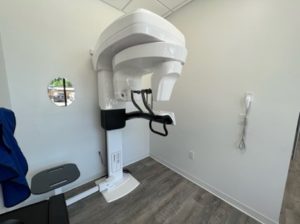
Here at Fort Worth Snoring & Sleep Center, technology plays a large role in helping us provide top-quality care for patients. One of the advanced instruments that we use is a CBCT machine, which is sometimes referred to as a cone beam scanner. What exactly is a CBCT machine, and how can it help us as we serve patients who are suffering from TMJ disorder or sleep apnea in Fort Worth? Read on below to discover the answers.
What Is a CBCT Machine?
CBCT stands for “cone beam computed tomography.” It uses the same type of radiation as a regular X-Ray machine to capture images. However, it is able to provide an elevated level of detail. The beam of radiation that it uses is cone-shaped, which means that the images produced are both three-dimensional and able to show our team remarkable and small details about a patient’s TMJ, head, neck, sinuses, and airway.
There are a number of CBCT machines on the market. The one we use in our practice is the CS 9600 by Carestream. It stands out amongst its contemporaries because it uses artificial intelligence to guide positioning, which can ensure consistent results and reduce the need for re-scans. The quality of the images it produces are also top-notch.
The Importance of CBCT Scans in Addressing Sleep Apnea and TMJ Disorder
Our CBCT machine can help patients who are suffering from obstructive sleep apnea because it reveals valuable information about the airway. It can show us which parts of your anatomy are normal and which parts may be responsible for disruptions in your breathing while you sleep. Armed with such details, we can recommend the best way for you to address the problem.
The machine is also important when it comes to addressing problems with the TMJ in Fort Worth. When a patient is suffering from symptoms like jaw pain, headaches, and difficulty chewing, the root cause of the issue could be any number of things. For example, it could be arthritis, an injury, a poorly aligned bite, or something else. A CBCT scan helps us as we strive to pinpoint why a patient is suffering. After this part of the diagnostic process, we are in a better position to recommend an appropriate treatment.
What to Expect During a CBCT Scan
The CBCT scanning process usually takes just a few minutes. It is also completely painless and noninvasive. First, you may have to remove any jewelry or other objects that could interfere with the images. Then, we’ll position you in the machine and begin the scanning process. The images will be ready for review very quickly.
Our CBCT machine makes an important contribution to our practice. If you have questions about it or any of the other technology we use, feel free to ask during your next appointment!
More About Our Practice
Dr. Mitch Conditt began his career as a general dentist, but things changed in 2009, when he was diagnosed with obstructive sleep apnea. In the years since then, he has become a true expert in the field of sleep dentistry. His expertise also extends into treatment for TMJ disorders. If you would like to learn more about Dr. Conditt and how he may be able to serve you, contact our office at 817-527-8500.
